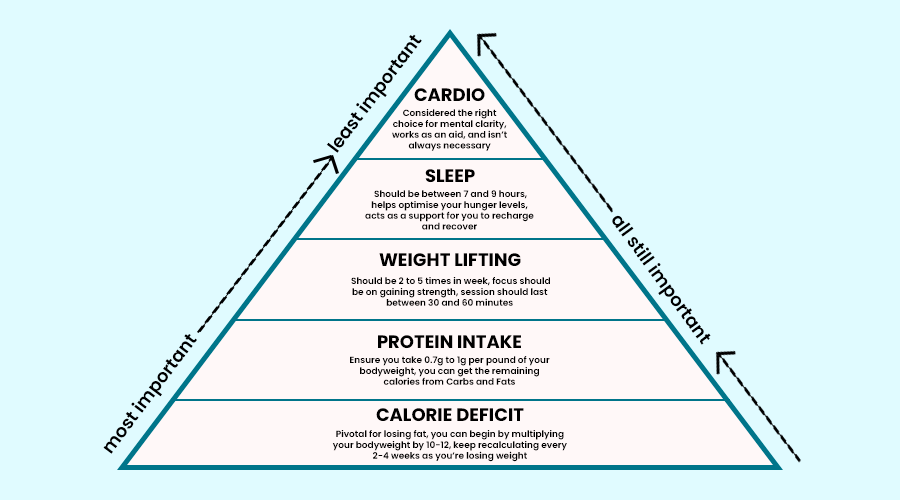

Training hard to reach your fitness goals without following a proper diet is not going to help you. You will be getting ripped with strenuous training with no results and could be demotivating as hell. For effective fat loss, watch what you eat, burn more calories than you consume, and see the difference.
The pattern of nutrients in your diet also changes according to your training. You will need to add foods rich in nutrients that help in building lean mass, strengthen your muscles, help in recovery and repair of muscles and also provide the energy required to sustain the tedious training.
To establish the calorie deficit and raise the chances of reaching your fitness goals you will have to include high-intensity interval training. The intensity of your training will also ramp up with less rest between sets. You will need a lot of energy to fuel your intense sessions and supplements that aid your energy supply will be beneficial.
The golden pyramid of fat loss is devised with strategies to help you succeed in your fat loss goal. There are levels incorporated with different grades of importance attached. The bottom level is the most important and supports the rest of the levels above it. Unless you show 100% commitment to achieving the bottom level, the efforts you put in on the other levels will be in vain.
Strategies of the Golden Pyramid of Fat Loss
The Golden Pyramid of fat loss is designed to make the fat loss journey more purposeful. The various levels from the bottom to the top are explained in detail. The bottom level is the most important, focus on attaining the bottom level should be your first step.
1. Create a Calorie Deficit
This is the first level where the golden rule of burning more calories than you take in should be followed with great earnestness. A calorie deficit is a key to fat loss. For this, you will have to first determine the calories you require to establish this calorie deficit.
With basic information like size, goals, and exercise routine, you can calculate the calorie and macros requirement per day to reach your fitness goal, which is fat loss goal. A calorie deficit of 300 to 700 calories a day, will help you lose about 0.5 to 1.5 pounds in a week. This again depends on your body weight.
You should then have a diet plan for weight loss that will provide you with the calories and macros required for fat loss. With the diet plan if you are shedding weight then you have successfully created a calorie deficit. Follow the diet plan till the weighing scale moves upwards. If so, then you will have to reduce the calorie intake by 10 to 20%.
Your weight loss should be gradual as fast weight loss will result in muscle loss which is not what you want.
2. Assess the Macronutrients Required
The next step is drawing a diet plan for fat loss. The diet should not be restricting calories but should also provide the required macronutrients to reach your specific fitness goals. When you are on a fat loss goal, maintaining muscle mass is as important as shedding those extra pounds.
Protein intake is crucial to keep you satiated for longer and restrict your calorie intake. If your protein intake is low then there is a likelihood that your muscle mass will be used up as energy. In the process of including more protein, the purpose of creating a calorie deficit should not be defeated. Instead, you should lower the intake of carbs and fats or maintain a balance between these nutrients.
Keep a track of your calorie intake during the first few weeks, so that you can adjust your diet plan for weight loss. Fats and carbs are crucial to provide the energy to improve your exercise performance. Follow these precious fat loss tips for cutting down on calories and including sufficient micro and macronutrients to improve exercise performance and recovery and see the difference.
You can include carbs in your pre and post-workout meals to enhance your gym performance. You can also manipulate the carbs intake according to your training. The choice of carbs also plays an important role. Simple carbs tend to spike blood sugar levels and are most likely to be stored as fat. Complex carbs digest and get absorbed slowly. This will give a steady supply of energy for long hours which will keep your appetite in control.
3. Draw a Proper Training Chart
Once you have incorporated all the fat loss tips in your diet plan and all set with the nutrition aspect of the golden pyramid for fat loss, the next step will be your training chart.
- Your fat loss workout plan should focus on exercises that work on multiple joint muscles [a muscle crosses more than 1 joint] rather than isolation exercises. But for some muscles, especially arms and shoulders, isolation exercises work better. In multi-joint exercises, since you are engaging more than one muscle, you can push more weights which will help in better metabolism. Multi-joint exercises will also stimulate an array of anabolic hormones. This translates into better fat burning as well as muscle growth.
- Training with heavy weights with short rest intervals is recommended to enhance metabolism. More repetitions with lighter weights do not work well with fast-twitch muscle fibres. They tend to grow faster with resistance training and may be subject to loss when they are not targeted.
- Also reducing the rest period during sets will help fat burning. More activity between sets or limiting the rest periods will prove beneficial in fat loss. Your work-to-rest ratio should be maintained at 1-to-1. Initially, it will be difficult but eventually, your body will adapt to this pattern.
- You know you need to burn more calories to get lean, but increasing the length of your workout isn’t the answer when you’re on a low-calorie diet. Catabolic hormones such as cortisol can begin to rise after about an hour of high-intensity exercise. Instead, use intensity principles such as rest-pause, drop sets, supersets, cluster sets, and density training, on your final exercise to increase the volume.
- If you want to improve your conditioning and increase excess post-exercise oxygen consumption (EPOC), then you need to work out at a higher intensity. This procedure will take up to 24 hours to complete, depending on the individual’s fitness level.
- With all the efforts put in with strength training the calorie deficit may not be adequate to aid fat loss. Adding a cardio workout can help create a calorie deficit by facilitating higher calorie burning. High-intensity interval training (HIIT) involves cycling periods of high-intensity work with easier ones for recovery. It can help you burn more calories and fat in less time than steady-state because of its effect on metabolism.
4. Include Supplements for Energy and Fat Loss
When you’re cutting calories, it can be especially difficult to meet your micro and macronutrient requirements which may hamper your training routine to aid fat loss. This is where a good supplement can come in handy. Increased protein consumption is linked to higher rates of satiety and energy expenditure.
Caffeine-containing supplements have been shown in studies to improve the rate of fat breakdown and reduce perceived exertion during exercise. Supplementing with omega-3 fatty acids has been shown to increase fat burning while also increasing protein synthesis and muscle gain, among other benefits. Fish oil supplements help in losing body fat while increasing fat-free mass. A combination of caffeine and green tree extract is great for fat loss and energy generation.
Intense and dense fat-loss training sessions lead to hydrogen ion accumulation which lowers your blood’s pH level and contributes to fatigue. Beta-alanine aids in the production of Carnosine, a building block of protein, and acts as a buffer for hydrogen ions. This improves your exercise performance.
Calcium and vitamin D are two other supplements to think about. A calcium-rich diet has been shown to increase fat oxidation, decrease fat absorption, and aid in appetite control, whereas vitamin D intake is associated with lower levels of adiposity and improved metabolic health.
Conclusion
Fat loss necessitates critical foundational strategies, but your chances of success increase when you address all levels of the fat-loss pyramid. Nailing the bottom level of the pyramid i.e., creating a calorie deficit will enhance the effect of the other levels of the pyramid to achieve your fat loss goals.




